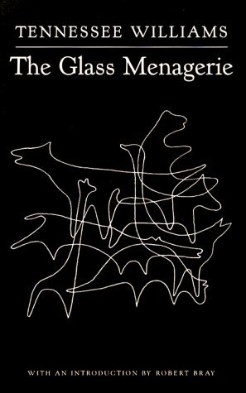The Wingfield apartment is in the rear of the building, one of those vast hive-like conglomerations of cellular living-units that flower as warty growths in overcrowded urban centers of lower middle-class population and are symptomatic of the impulse of this largest and fundamentally enslaved section of American society to avoid fluidity and differentiation and to exist and function as one interfused mass of automatism.
The apartment faces an alley and is entered by a fire escape, a structure whose name is a touch of accidental poetic truth, for all of these huge buildings are always burning with the slow and implacable fires of human desperation. The fire escape is part of what we see — that is, the landing of it and steps descending from it.
The scene is memory and is therefore nonrealistic. Memory takes a lot of poetic license. It omits some details; others are exaggerated, according to the emotional value of the articles it touches, for memory is seated predominantly in the heart. The interior is therefore rather dim and poetic.
At the rise of the curtain, the audience is faced with the dark, grim rear wall of the Wingfield tenement. This building is flanked on both sides by dark, narrow alleys which run into murky canyons of tangled clotheslines, garbage cans, and the sinister latticework of neighboring fire escapes. It is up and down these side alleys that exterior entrances and exits are made during the play. At the end of Tom’s opening commentary, the dark tenement wall slowly becomes transparent and reveals the interior of the ground-floor Wingfield apartment.
Nearest the audience is the living room, which also serves as a sleeping room for Laura, the sofa unfolding to make her bed. Just beyond, separated from the living room by a wide arch or second proscenium with transparent jaded portieres (or second curtain), is the dining room. In an old-fashioned whatnot in the living room are seen scores of transparent glass animals. A blown-up photograph of the father hangs on the wall of the living room, to the left of the archway. It is the face of a very handsome young man in a doughboy’s First World War cap. He is gallantly smiling, ineluctably smiling, as if to say “I will be smiling forever.”
Also hanging on the wall, near the photograph, are a typewriter keyboard chart and a Gregg shorthand diagram. An upright typewriter on a small table stands beneath the charts.
The audience hears and sees the opening scene in the dining room through both the transparent fourth wall of the building and the transparent gauze portieres of the dining-room arch. It is during this revealing scene that the fourth wall slowly ascends, out of sight. This transparent exterior wall is not brought down again until the very end of the play, during Tom’s final speech.
The narrator is an undisguised convention of the play. He takes whatever license with dramatic convention is convenient to his purposes.
Tom enters, dressed as a merchant sailor, and strolls across to the fire escape. There he stops and lights a cigarette. He addresses the audience.
TOM: Yes, I have tricks in my pocket, I have things up my sleeve. But I am the opposite of a stage magician. He gives you illusion that has the appearance of truth. I give you truth in the pleasant disguise of illusion.
To begin with, I turn back time. I reverse it to that quaint period, the thirties, when the huge middle class of America was matriculating in a school for the blind. Their eyes had failed them, or they had failed their eyes, and so they were having their fingers pressed forcibly down on the fiery Braille alphabet of a dissolving economy.
In Spain there was revolution. Here there was only shouting and confusion. In Spain there was Guernica. Here there were disturbances of labor, sometimes pretty violent, in otherwise peaceful cities such as Chicago, Cleveland, Saint Louis . . . This is the social background of the play.
[Music begins to play.]
The play is memory. Being a memory play, it is dimly lighted, it is sentimental, it is not realistic. In memory everything seems to happen to music. That explains the fiddle in the wings.
